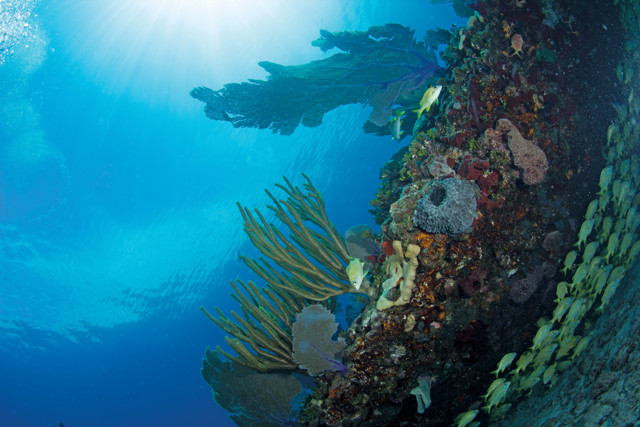
by Bethany Augliere Tuesday, November 15, 2016

Reefs that lack large predatory fish have 50 percent fewer nutrients. Credit: Nicodemo Lentile.
With multiple threats facing our coral reefs — from climate change to overfishing — and scientists continually studying the coral reefs beneath the waves, new findings are announced often. Here are a few of the latest updates.
The health of coral reefs depends on large fish and their waste, according to a new study in Nature Communications, led by Jacob Allgeier, a biologist at the University of Washington. When fish urinate, they release critical nutrients such as phosphorus and nitrogen that fertilize the reefs. Allgeier spent four years collecting hundreds of live fish to measure urine output. He found that large carnivorous fish excreted more phosphorus than smaller herbivores. The team used these data to model the impacts on reefs of fish biomass, by surveying 143 fish species at 110 sites spanning 43 Caribbean coral reefs, which experienced different levels of fishing, including a total ban at some located in marine preserves. Reefs that lacked large predatory fish due to increased fishing pressure had 50 percent fewer nutrients. “Simply stated, fish biomass in coral reefs is being reduced by fishing pressure,” Allgeier said in a statement. “If biomass is shrinking, there are fewer fish to pee.”
Coral reefs in the eastern Pacific Ocean experience frequent environmental disturbances and harsh conditions that make building reef structures difficult. In 1998, these eastern Pacific coral populations were devastated by a severe bleaching event. Scientists have hypothesized that El Niño events may help replenish the population, by transporting coral larvae from the western to the eastern Pacific via strengthened currents. But according to a new study in Nature Communications, the coral larvae cannot survive the 5,000-kilometer journey across the vast open ocean separating the two populations. Using a supercomputer based at the University of Bristol in England, researchers simulated the movement of billions of coral larvae traveling along ocean currents, from 636 reef sites over 14.5 years, from 1997 to 2011. The biophysical model combines oceanographic data with coral biology. Even during the extreme 1997–1998 El Niño event, the larvae could not survive. To confirm their results, the researchers compared model data with genetic data. Whether or not coral reefs can survive the pressure of climate change as well as local stresses will depend to a large extent on the ability of coral to reproduce and disperse to replenish damaged populations, migrate from deteriorating conditions and colonize new frontiers, said Sally Wood, a coral reef biologist at the University of Bristol and lead author of the paper, in a statement. “So it’s important to map where coral are able to get to.”
Shallow reefs dominated by tidal action account for roughly one-third of reefs around the world, yet are relatively understudied. In a new study published in Science Advances, Australian researchers found that rising sea levels could actually protect these reefs from the effects of global warming, such as bleaching, by reducing local water temperature extremes above the reefs. The team, led by Ryan Lowe at Western Australia University, developed a model to examine how the sun, tides and structure of the reef drive temperature variation, by tracking the heat exchange on the reef with the atmosphere and ocean water. The team measured variables such as water currents, temperature, wind speed and direction, and relative humidity for two weeks at reefs off the coast of northwestern Australia. They found that the greatest temperature variation occurred during mid-day low tides, during periods of the most solar heating. The shallow water trapped on the reef could heat up more, whereas at high tides, temperatures were more stable. When future sea-level rise, based on Intergovernmental Panel on Climate Change projections, was incorporated into the models, maximum temperatures at these sites decreased up to 65 percent with 0.7 meters of sea-level rise and up to 86 percent with 1.5 meters. With more water over the reefs, the deeper water would heat up less and also provide greater exchange with cooler ocean water.
© 2008-2021. All rights reserved. Any copying, redistribution or retransmission of any of the contents of this service without the expressed written permission of the American Geosciences Institute is expressly prohibited. Click here for all copyright requests.